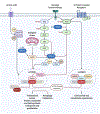Challenges and Emerging Opportunities for Targeting mTOR in Cancer
- PMID: 36321262
- PMCID: PMC9634680
- DOI: 10.1158/0008-5472.CAN-22-0602
Challenges and Emerging Opportunities for Targeting mTOR in Cancer
Abstract
The mechanistic target of rapamycin (mTOR) plays a key role in normal and malignant cell growth. However, pharmacologic targeting of mTOR in cancer has shown little clinical benefit, in spite of aberrant hyperactivation of mTOR in most solid tumors. Here, we discuss possible reasons for the reduced clinical efficacy of mTOR inhibition and highlight lessons learned from recent combination clinical trials and approved indications of mTOR inhibitors in cancer. We also discuss how the emerging systems level understanding of mTOR signaling in cancer can be exploited for the clinical development of novel multimodal precision targeted therapies and immunotherapies aimed at achieving tumor remission.
©2022 American Association for Cancer Research.
Figures

References
-
- Janku F, Yap TA, Meric-Bernstam F. Targeting the PI3K pathway in cancer: are we making headway? Nat Rev Clin Oncol 2018;15:273–91 - PubMed
Publication types
MeSH terms
Substances
Grants and funding
LinkOut - more resources
Full Text Sources
Medical
Miscellaneous

